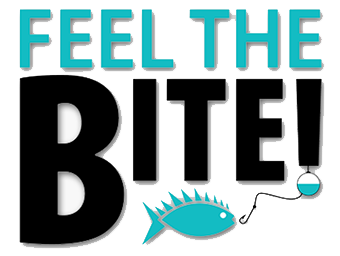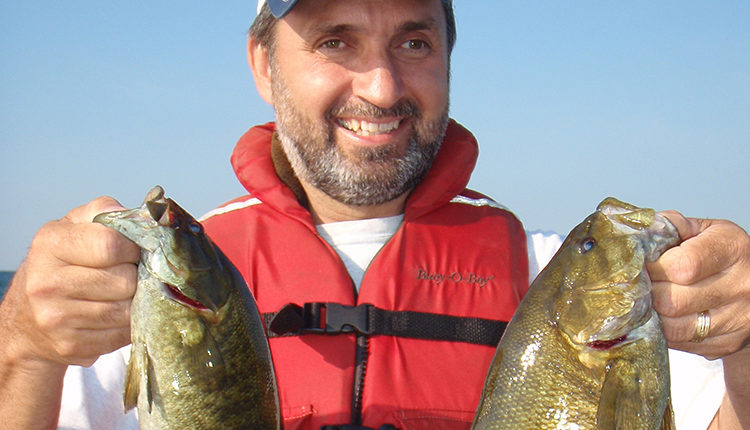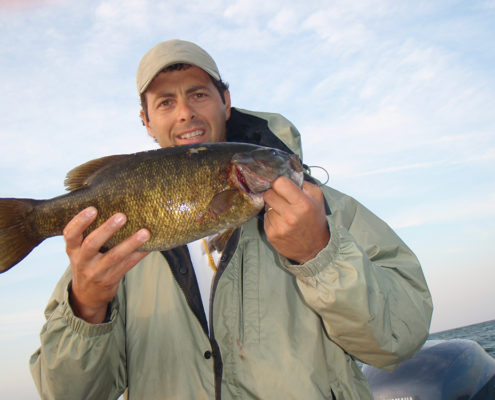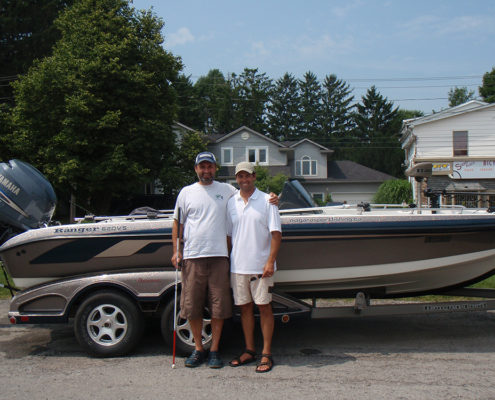Drop-Shot Drifting for Mid-Summer Smallies
When it comes to fishing techniques there always seems to be exceptions to the rules. Blending together two fishing styles, dragging tubes and drop-shotting, constitutes a real blurring of accepted practices. This hybrid style was recently taught to me on Lake Erie by frank Dimarcantonio. Boating a load of Smallmouth Bass that morning made me a believer.
Frank Dimarcantonio operates Niagara Sport Fishing, (www.niagarasportfishing.ca), specializing in catching Smallmouth Bass from March through June on the US shores of Lake Erie, Musky on the Upper Niagara River during summer months, Lake Erie Smallies again in the fall, and finally Steelhead on the Lower Niagara from November through to May. Yup, this Canadian books charters year-round and none of it takes place on ice.
We launched Franks Ranger 620VS out of Fort Erie at the mouth of the Niagara River. Smallmouth are scattered by late July and tracking down the big ones was going to involve cruising deeper sections of water (40’-60’) using electronics to mark suspending Bass. This was our plan anyway, but a thunderhead building in the west had us adopting plan B.
In spring Frank prefers dragging tubes on the American side for pre-spawn fish, (Bass season is open year round on the US side of Lake Erie). However, Frank believes drop-shotting is far more effective for catching Mid-summer Smallies. It’s how Frank incorporates drifting with drop-shotting that gives a twist to an already popular style of fishing.
Drop shot is a technique that excels as a slack-line presentation. Great when boat handling isn’t an issue, but the winds and waves on Lake Erie seldom make drop-shotting from a relatively stationary boat possible. Fishing Lake Erie means big water, and to find fish you also need to be on the move.
With the bottom of Lake Erie near the mouth of the Niagara River consisting of alternating sand-bars and stones, locating unique structure often comes down to the difference of a few large rocks. That morning the west wind was significant and with the strong current, finding anomalies in the bottom’s composition was no easy feat. Thankfully, Frank’s ability to drift from one GPS point to another was excellent – made possible in part to his Lowrance side and down imaging sonar and 36V Minn Kota operated via a wireless Co-Pilot remote.
Frank explained that the challenge with drop-shotting during a controlled drift is keeping your line as near vertical as possible, while at the same time never letting your weight lift from the bottom. Keeping your weight on the bottom means your bait stays in the strike zone and keeps the weight from spooking fish. Too much line behind the boat and the sensation transmitted to the rod is muddied. It also decreases the angle of your line to the bottom reducing your ability to impart any action to the bait by introducing slack, and increases the probability of picking up weeds or damaging hook points on rocks.
Frank prefers a 4 lb Fluoro leader tied to 8 lb main line with a miniature swivel. He always uses pencil weights as they are ideal for dragging being less likely to get wedged, where as round weights offer more grip. He ties on his #1 Gamakatsu drop-shot hooks anywhere from 6” to 3’ above the weight depending on whether fish are hugging bottom or suspending, And started the day with about 18” between hook and a ½ oz weight as our drift speed was going to be faster than normal due to the much higher than average wind speeds. Weight size has an upper limit when fishing lighter tackle.
During the drift Frank regularly drops his rod tip while at the same time imparting action into the bait by moving his tip left to right. Never up and down as this lifts the weight off the bottom taking away from the natural action of the bait and possibly spooking weary fish. He then brings his rod tip slowly back dragging the weight along the bottom, and repeats the process. It’s possible to take things one step further by replacing the drop-shot weight with a tube.
Frank prefers a medium-light baitcast outfit over a spinning outfit due to less line twist generated by numerous fish repeatedly peeling off the same 10-30 feet of line. Nevertheless, I took the opportunity to shake-down my new Shimano Cumulus 6’5” and Stradic C4 spinning outfit spooled up with 6 lb fluoro. The Cumulus is built extremely light in every respect but at no time did I feel overwhelmed by the aquabatics Smallies are famous for. I did notice some line twist by end-of-day, but nothing that couldn’t be taken care of by a little empty-line dragging behind the boat.
All our hits came on a slack-line shake, with Strike Zone Slammers boating the first of at least 40 Smallies caught that morning. We caught fish consistently before getting blown off the lake by 3’-4’ white-caps. The Smallmouth caught while the skies were overcast did all they could to stay down, whereas fish caught during a period of strong sunlight shot towards the surface after feeling the sting of the hook which made for some frantic reeling.
Sensations transmitted up the rod included an irregular soft bumping feel as the weights tumbled over small rock and gravel, to a feeling of steady sluggishness as weights slid over sand. This later sensation was similar to the feel of the weight gliding through water, but the urge to release more line to verify contact with bottom was resisted to maintain as vertical a presentation as possible. Monitoring the depth on the sounder alerted us to what our presentations were to pass over next.
A more surprising sensation experienced on occasion occurred when the weight was pulled up the side of a large rock, and then free-fell down the other side. This was a little unnerving, but maintaining cool was crucial as a false hook set at that moment would have meant pulling the bait away from fish using these larger rocks as cover.
Feel of the actual bite came in several different flavours. There’s the single tap which differs in intensity from that of the weight tumbling over small stones. The second bite sensation was resistance, similar to what one feels when the weight is climbing over a large rock, with the difference being that Bass mouthing the bait eventually clamped down to stop what they believe to be their meal attempting to squirm free. In either case, setting the hook with any measure of force wasn’t necessary as a simple sweep of the rod’s tip to the side or reeling in hard generally sufficed. The finer wire ultra-sharp drop-shot hooks on the market today almost set themselves, and an aggressive hook set can work against you by either bending the hook or pulling your bait out of the strike zone as Bass will often impart several nips to the tail of the bait before committing.
Frank made me a believer that drop shotting can be successfully executed from a carefully controlled boat under drift. The key lessons are to keep the weight on the bottom and impart continuous action to the bait by dropping your rod tip and then quivering it side-to-side. Seems simple enough, but long periods of concentration are crucial if bottom contact is to be maintained, regular action imparted and, most importantly, bites detected. A big thanks to Frank for the on-the-water introduction to drop-shot drifting for mid-summer Smallies.






